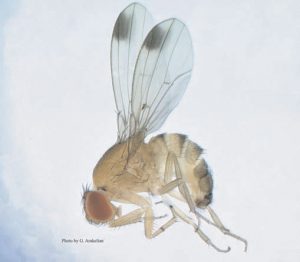
Drosophila suzukii or Cherry vinegar fly, a type of fruit fly endemic to Japan and Asia, poses a serious threat to European wine and fruit growing, warns the European Plant Protection Organization (EPPO). The male of the Cherry vinegar fly has wings with distinctive black spots. The first flys were observed in 2009 in Trentino in Italy. The species has now spread to South Tyrol, France, Spain, Slovenia and, since last summer, to Switzerland. The Drosophila suzuki is just one of two types of fruit flies that are a threat to healthy fruits. It lies its eggs in ripe berries. Larvae then eat the fruit from the inside. Control is particularly difficult, because the flies lay their eggs just before the fruit is ripe, so that treatment with insecticides is no longer possible. Only strict hygiene measures are able to combat it. Fallen fruit must be removed immediately and destroyed. This can be done by burying them at least thirty centimeters deep in the soil, by freezing them or by putting the fallen fruit in sealed bags until the flies and larvae are dead. Scientists believe that Drosophila Suzuki will spread in the coming years all over Central and Southern Europe. Earlier, the pest was introduced into North America were it spread rapidly, causing substantial damages.
Baufeld, Peter, Schrader, Gritta & Unger, Jens-Georg. “Die Kirschessigfliege – Drosophila suzukii – Ein neues Risiko für den Obst- und Weinbau. The Cherry vinegar fly – Drosophila suzukii – An emerging risk for fruit and wine growing.” In JOURNAL FÜR KULTURPFLANZEN, 62 (5). S. 183–186, 2010. (pdf)
